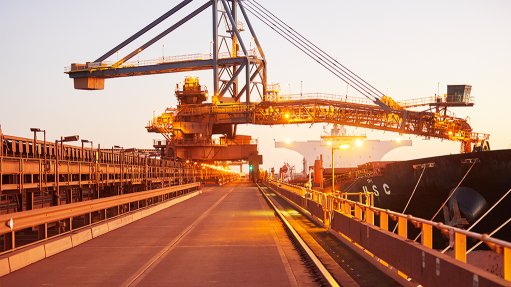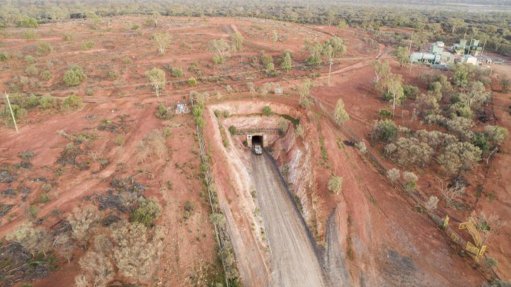JSE resource listings plunge 50% in last 20 years, total market cap at R2.82tr
Although the resource listings on the JSE have declined significantly over the last 20 years, from 130 listed mining companies in 1994 to only 66 basic resource companies (in the mining and industrial metals, as well as the mining sectors), the total market capitalisation of mining companies listed on the JSE has grown substantially to the current R2.82-trillion of the JSE’s total R12.19-trillion market capitalisation.
Comprehensive JSE records date back to 2002, when the data began to be arranged according to sector. In that year, the JSE had 52 listed basic resource companies with a total market capitali- sation of almost R645-billion.
JSE business development manager Patryjca Kula tells Mining Weekly that, while the number of listed mining companies alone is not an accurate reflection of how the industry is faring, it provides an indication of how the structure of the market has changed.
For instance, since the global economy started to show signs of recovery post 2008, the JSE has also registered a small increase in the number of listings this year.
Monetary policy, which determines the cost of raising capital through its influence on interest rates, has also had an influence on listings.
Professional services firm Venmyn Deloitte MD Andy Clay attributes the decline in resource listings to the lifting of sanctions on South Africa in 1994, which enabled South African mining companies to list anywhere in the world. This was particularly true for gold mines, as the market arbitrage value per ounce at the time was reflected by a discount of Witwatersrand companies compared with the rest of the world. Therefore, it made sense for South African assets to be listed elsewhere and to merge or acquire other gold assets.
South Africa becoming a democracy also led to the consolidation of previously listed companies, which influenced listings and how funding was traditionally raised.
“There is no doubt that the tension in the mining industry has affected investor sentiment toward South Africa,” says Kula, adding that recent comments from ratings agencies Standard & Poor’s and Fitch Ratings reflect this. Both agencies warned in June that industrial action was inhibiting South Africa’s economic growth.
“Meanwhile, ratings agency Moody’s Investors Services cautioned that the country’s “strike-prone economy” could harm South Africa’s reputation,” she adds.
Clay concurs, adding that when investors take note of any country’s downgraded status, they become aware that investing in that country is risky.
He tells Mining Weekly that the perception among investors is that the country is also a highly regulated environment, subject to South African regulatory authorities, including the national Reserve Bank, the South African Revenue Service and the Department of Mineral Resources. This, compounded by a currency that is performing extremely poorly, is influencing capital outflow, he says.
Clay further notes that thresholds for investing in foreign assets have also been changed by the Reserve Bank, which, in turn, has affected the number of listings on the JSE.
“Mining companies have been able to invest rands in foreign capital through asset swops, which has allowed for South African capital to be invested elsewhere; these mining companies are hedged through asset swaps,” he says.
Meanwhile, financial services group Cadiz Corporate Solutions mining and resources division head Peter Major reasons that the macro factors, which one cannot control, such as pricing and mineral resources, are in South Africa’s favour. Therefore, the micro factors, which one can control, such as the poli- tical environment, are likely drivers of mining companies delisting.
He believes that government is partly to blame for the lack of investment in South African mining. “If our social and political environment was conducive to investment, foreigners would want to invest in our mining industry,” he asserts.
Further, if South African investors, like African investment manager the Public Investment Corporation, were investing in the country, then foreigners would follow suit, says Major.
He points out that foreign investors perceive mining companies operating in South Africa as being “under siege” and facing a lack of government intervention, as was reflected by this year’s crippling five-month platinum-sector strike.
Major believes that government should be encouraging large companies, such as the mining majors, to list on the JSE, as it ensures greater transparency and compliance with local laws and regulations.
Despite this, the value of basic resource shares on the JSE has increased in the last year, from R2.4-trillion to R2.82-trillion.
With this in mind, Kula maintains that share prices and the choice to invest in any company or sector are never based on a single factor. Companies take several vari- ables into account when deciding whether to list and what destination to list on. Some of these variables include a country’s regulatory environment, listing standards, the cost of listing, the quality of institutional investors and the participation of foreign investors.
According to Switzerland-based nonprofit organisation the World Economic Forum’s Global Competitiveness Survey for 2013/14, the option of using South African equities to raise finance was ranked second worldwide.
Kula highlights that South African investors have a comprehensive understanding of resource companies and an appetite for investing in them. “Where there are known assets and managements, you will find a willing buyer,” she says.
Clay notes that the foreign capital coming into South Africa is from investors with some knowledge of the local market.
Why List?
Major says there are positive and negative aspects to South Africa’s listing environment, but adds that investors will ultimately invest in countries and on stock exchanges that have the highest return on investment.
The JSE believes that listing on the exchange makes sense for mining companies with African assets, as it is a good listing venue. Proof of this is that major mining companies, such as global diversified miner Glencore, have chosen to list on the JSE.
Further, the JSE has confirmed to Mining Weekly that it is currently in talks with several South Africa-focused mining companies about the possibility of listing on the JSE.
To ensure that investment remains in South Africa’s mining assets, as opposed to the numerous other global stock markets, the JSE aims to provide investors with a secure and stable environment in which to trade.
However, the JSE has no control over where investors ultimately choose to invest and cannot control the investment prospects of any industry. “As an exchange, it can only ensure that it provides the strongest possible market infrastructure to serve investors and to make it as easy as possible for companies that want to list.”
She adds that the JSE offers good trading systems, liquidity and stock market regulation, strong protection of legal title, easy entry to and exit from the market for foreign investors, as well as the remitting of funds.
“These factors are what keep companies listed on the JSE and drive other resource companies to consider us as a listing destination,” says Kula.
JSE Listings and Delistings
South Africa’s basic resources sector, which includes mining and industrial metals (aluminium, nonferrous metals, iron and steel) and mining sectors (coal, diamonds and gemstones, general mining, gold mining and platinum-group metals), contributes R2.82-trillion to the overall JSE market capitalisation of R12.19-trillion.
Of the 66 basic resource companies listed at the moment, 35 companies are dual-listed.
Fifteen basic resource companies listed on the JSE’s main board and the JSE’s alternative exchange, the AltX, in the last five years, while 23 basic resource companies delisted in the same period, one of which was a voluntary delisting.
Major believes that companies may be asked to delist as a result of insufficient two- way trade in their shares or they may intend to delist voluntarily if they cannot raise sufficient capital.
Companies may also delist because of failure to comply with JSE listing requirements or a scheme of arrangement.
Major predicts that the trend in JSE delistings will continue, adding that mining companies are also delisting on other stock markets worldwide.
“US and Chinese stock markets have, to an extent, made it difficult for companies to list on their stock exchanges, despite it being to the detriment of their governments and countries.”
The likely reason for this trend is that governments are becoming more populist, as opposed to being principled, as they are more aligned with public opinion now than ever before.
Clay, too, believes that the number of resource companies being listed is going to stagnate “until there is a change in investor perception of the benefits of investing in South African mining assets.”
However, he notes that the exception will be oil and gas companies and companies interested in other unconventional commodities, such as coal-bed methane and shale gas.
There are currently four listed oil and gas companies on the JSE, with a total market capitalisation of almost R400-billion. The latest oil and gas listing on the JSE, which took place in February, was the listing of US-based, Africa-focused oil and gas exploration and production company Camac Energy on the bourse’s main board.
Dual-listed Camac Energy’s asset portfolio consists of nine licences, covering an area of 43 000 km2 across four countries, including production and other projects off the cost of Nigeria, as well as exploration licences off the coasts of Ghana, Kenya and the Gambia, and onshore in Kenya.
Clay expects future large transactions to largely take place in the coal, power and oil and gas sectors, as they are regarded as less risky than other commodities in South Africa’s mining sector, which suffer from significant commodity price volatility.
In addition, South Africa continues to be associated with uncertainty in the cost and productivity of labour, compared with elsewhere, he says. This is borne on by the extent that a number of South African miners have called on Australian mining consultants to advise on comparable workforce efficiencies.
Comments
Press Office
Announcements
What's On
Subscribe to improve your user experience...
Option 1 (equivalent of R125 a month):
Receive a weekly copy of Creamer Media's Engineering News & Mining Weekly magazine
(print copy for those in South Africa and e-magazine for those outside of South Africa)
Receive daily email newsletters
Access to full search results
Access archive of magazine back copies
Access to Projects in Progress
Access to ONE Research Report of your choice in PDF format
Option 2 (equivalent of R375 a month):
All benefits from Option 1
PLUS
Access to Creamer Media's Research Channel Africa for ALL Research Reports, in PDF format, on various industrial and mining sectors
including Electricity; Water; Energy Transition; Hydrogen; Roads, Rail and Ports; Coal; Gold; Platinum; Battery Metals; etc.
Already a subscriber?
Forgotten your password?
Receive weekly copy of Creamer Media's Engineering News & Mining Weekly magazine (print copy for those in South Africa and e-magazine for those outside of South Africa)
➕
Recieve daily email newsletters
➕
Access to full search results
➕
Access archive of magazine back copies
➕
Access to Projects in Progress
➕
Access to ONE Research Report of your choice in PDF format
RESEARCH CHANNEL AFRICA
R4500 (equivalent of R375 a month)
SUBSCRIBEAll benefits from Option 1
➕
Access to Creamer Media's Research Channel Africa for ALL Research Reports on various industrial and mining sectors, in PDF format, including on:
Electricity
➕
Water
➕
Energy Transition
➕
Hydrogen
➕
Roads, Rail and Ports
➕
Coal
➕
Gold
➕
Platinum
➕
Battery Metals
➕
etc.
Receive all benefits from Option 1 or Option 2 delivered to numerous people at your company
➕
Multiple User names and Passwords for simultaneous log-ins
➕
Intranet integration access to all in your organisation





















